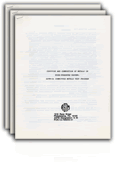We need your consent to use the individual data so that you can see information about your interests, among other things. Click "OK" to give your consent.

The information about the standard:
Designation standards: ASTM ADJG0094
Note: Adjunct of the standard
SKU: NS-1066856
Approximate weight : 300 g (0.66 lbs)
Country: American technical standard
Category: Technical standards ASTM
Annotation of standard text ASTM ADJG0094 :

The data contained in this adjunct to ASTM STd-G94 is based on NASA White Sands Test Facility report TR-477-001, "Test Report ASTM G-4 Committee Metals Test Program" dated February 7, 1989. Twenty-six metals were tested in the NASA White Sands Test Facility promoted combustion, frictional heating, and particle impact test systems. Their burn propagation and ignition characteristics were observed, and the metals were ranked according to their suitability for use in oxygen systems. In the promoted combustion tests, the solid rod specimens were subjected to heat released by a burning promoter at oxygen pressures up to 48 MPa (7000 psig). The highest pressure at which a test specimen would not burn more than 5 cm (2 in.), and the burnpropagation rates, were determined. In the frictional heating tests, the ends of two hollow cylinders were rubbed together in oxygen at 6.9 MPa (1000 psig). The energy flux (product of contact pressure and velocity) required to ignite the specimens was determined. In the particle impact tests, the specimens were impacted by a 2000-µm (0.078-in.) aluminum particle entrained in 28 MPa (4000 psig) oxygen that was flowing at supersonic velocity. The temperature at which the specimens ignited was determined.
This standard belongs to the adjunct
Standard Guide for Evaluating Metals for Oxygen Service
Standard published on 1.5.2022
Selected format:Show all technical information.
We recommend:
Technical standards updating
Do you want to make sure you use only the valid technical standards?
We can offer you a solution which will provide you a monthly overview concerning the updating of standards which you use.
Would you like to know more? Look at this page.




 Cookies
Cookies
